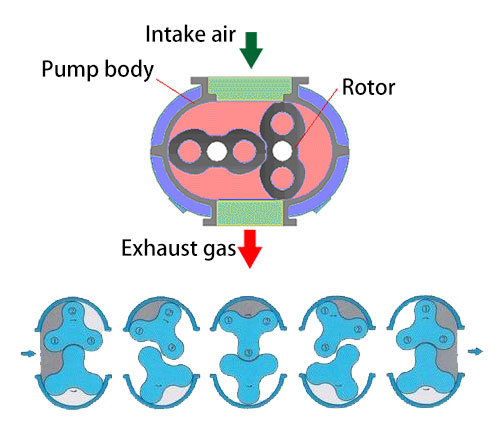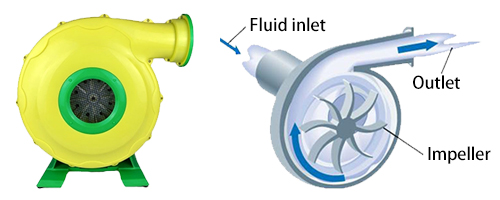Working Principle of Air Blower
The air blower is mainly composed of the following six parts: motor, air filter, air blower body, air chamber, base (and oil tank), oil dripping nozzle. The air blower operates by the eccentric rotor in the cylinder, and makes the volume change between the blades in the rotor slot to absorb, compress and eject the air. During the operation, the pressure difference of the air blower is used to automatically send the lubrication to the oil dripping nozzle and drop it into the cylinder to reduce the friction and noise, while keeping the gas in the cylinder from returning. Air blowers are mainly divided into roots air blower, centrifugal air blower and rotary air blower. The working principles of different types of air blowers are different.
Comparison of the working principles of Roots blowers, centrifugal blowers and rotary blowers.
1. Working principle of Roots air blower
Roots air blower is a constant volume fan, the air volume is proportional to the number of revolutions, and the three-blade impeller absorbs and exhausts air three times by two impellers every time it rotates. Compared with the two-blade impeller, it has less gas pulsation, less load change, high mechanical strength, low noise and small vibration. There are two trilobal impellers on the two parallel shafts. There is always a small gap between the wheel and the inner hole surface of the elliptical box and between the impellers. Because the impellers rotate in opposite directions at a constant speed, a certain amount of gas surrounded by the box and the impeller is transported from the suction side to the discharge side. Each impeller is always kept in the correct phase by the synchronous gear, so it will not touch each other, so it can be high-speed, does not need internal lubrication, and has the advantages of simple structure, stable operation, stable performance, suitable for a variety of purposes, and has been used in a wide range of fields.

2. Working principle of centrifugal air blower (same as centrifugal pump)
When the motor turns to drive the fan impeller to rotate, the gas between the blades in the impeller also rotates, and the gas is thrown out under the action of centrifugal force. The gas flow rate increases, so that the kinetic energy of the gas in the flow is converted into static pressure energy, and then with the pressurization of the fluid, the static pressure energy is converted into velocity energy, and the gas is discharged through the exhaust port, and a certain negative pressure is formed in the middle of the impeller Due to the negative pressure at the inlet, the external gas is immediately fed in under the action of atmospheric pressure, and the gas is continuously discharged and fed in under the action of continuous rotation of impeller, so as to achieve the purpose of continuous blowing. Under the same power, wind pressure and air volume are generally inversely proportional. Under the same power, if the air pressure is high, the air volume will be relatively low, and if the air volume is large, the air pressure will be lower, so as to make full use of the efficiency of the motor. For example, ATO's inflatable blowers are also centrifugal blowers, with power from 380W to 1.5kW (2 hp). These inflatable blowers are portable, easy to carry and store, durable, effective and economical in price. It can be used in medical equipment, environmental cleaning, lithium battery equipment, printing and other industrial fields.

3. Structure and working principle of rotary blowers
Pressure range of air blower: 0.1-0.5kgf/cm2. The rotary air blower has exquisite structure and is mainly composed of the following six parts: Motor, air transition device, air blower body, air chamber, base (also as oil tank) and oil dripping nozzle. The air blower operates by the eccentric rotor in the cylinder, and makes the volume change between the four blades in the rotor slot to absorb, compress and eject the air. During the operation, the pressure difference of the air blower is used to automatically send the lubrication to the oil dripping nozzle and drop it into the cylinder to reduce the friction and noise, while keeping the gas in the cylinder from returning.

